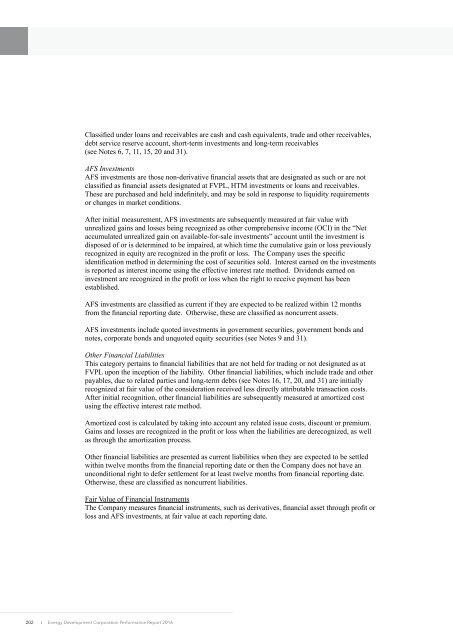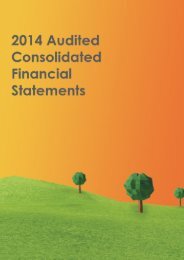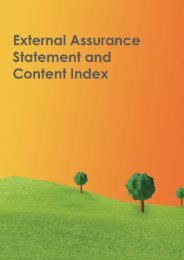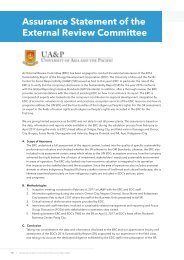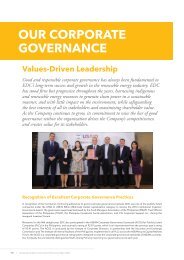EDC PR 2016 (FS section)
You also want an ePaper? Increase the reach of your titles
YUMPU automatically turns print PDFs into web optimized ePapers that Google loves.
Classified under loans and receivables are cash and cash equivalents, trade and other receivables,<br />
debt service reserve account, short-term investments and long-term receivables<br />
(see Notes 6, 7, 11, 15, 20 and 31).<br />
A<strong>FS</strong> Investments<br />
A<strong>FS</strong> investments are those non-derivative financial assets that are designated as such or are not<br />
classified as financial assets designated at FVPL, HTM investments or loans and receivables.<br />
These are purchased and held indefinitely, and may be sold in response to liquidity requirements<br />
or changes in market conditions.<br />
After initial measurement, A<strong>FS</strong> investments are subsequently measured at fair value with<br />
unrealized gains and losses being recognized as other comprehensive income (OCI) in the “Net<br />
accumulated unrealized gain on available-for-sale investments” account until the investment is<br />
disposed of or is determined to be impaired, at which time the cumulative gain or loss previously<br />
recognized in equity are recognized in the profit or loss. The Company uses the specific<br />
identification method in determining the cost of securities sold. Interest earned on the investments<br />
is reported as interest income using the effective interest rate method. Dividends earned on<br />
investment are recognized in the profit or loss when the right to receive payment has been<br />
established.<br />
A<strong>FS</strong> investments are classified as current if they are expected to be realized within 12 months<br />
from the financial reporting date. Otherwise, these are classified as noncurrent assets.<br />
A<strong>FS</strong> investments include quoted investments in government securities, government bonds and<br />
notes, corporate bonds and unquoted equity securities (see Notes 9 and 31).<br />
Other Financial Liabilities<br />
This category pertains to financial liabilities that are not held for trading or not designated as at<br />
FVPL upon the inception of the liability. Other financial liabilities, which include trade and other<br />
payables, due to related parties and long-term debts (see Notes 16, 17, 20, and 31) are initially<br />
recognized at fair value of the consideration received less directly attributable transaction costs.<br />
After initial recognition, other financial liabilities are subsequently measured at amortized cost<br />
using the effective interest rate method.<br />
Amortized cost is calculated by taking into account any related issue costs, discount or premium.<br />
Gains and losses are recognized in the profit or loss when the liabilities are derecognized, as well<br />
as through the amortization process.<br />
Other financial liabilities are presented as current liabilities when they are expected to be settled<br />
within twelve months from the financial reporting date or then the Company does not have an<br />
unconditional right to defer settlement for at least twelve months from financial reporting date.<br />
Otherwise, these are classified as noncurrent liabilities.<br />
Fair Value of Financial Instruments<br />
The Company measures financial instruments, such as derivatives, financial asset through profit or<br />
loss and A<strong>FS</strong> investments, at fair value at each reporting date.<br />
202<br />
I Energy Development Corporation Performance Report <strong>2016</strong>


